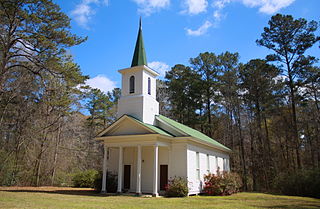
Coffeeville is a town in Clarke County, Alabama, United States. At the 2010 census the population was 352.

Thomasville is a city in Clarke County, Alabama, United States. At the 2010 census the population was 4,209. Founded as a late 19th-century railroad town, it has transitioned over the course of more than a century into a 21st-century commercial hub. It is the childhood hometown of author and storyteller Kathryn Tucker Windham.
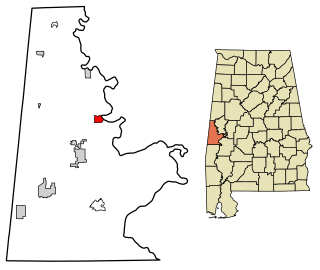
Epes is a town in Sumter County, Alabama, United States. Initially called Epes Station, it was incorporated as Epes in 1899. At the 2010 census the population was 192, down from 206 in 2000.
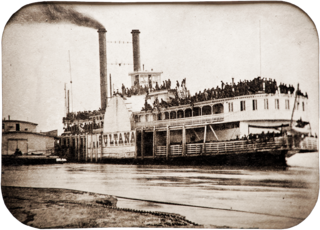
Sultana was a Mississippi River side-wheel steamboat. On April 27, 1865, the boat exploded in the worst maritime disaster in United States history. She was designed with a capacity of only 376 passengers, but she was carrying 2,137 when three of the boat's four boilers exploded and she burned to the waterline and sank near Memphis, Tennessee, killing 1,168 passengers. This disaster was overshadowed in the press by other events surrounding the end of the American Civil War, most particularly the killing on the previous day of President Lincoln's assassin John Wilkes Booth.

CSSBaltic was an iron and cottonclad sidewheeler ship built in 1860 in Philadelphia as a river tow boat belonging to the Southern Steamship Co. She was purchased by the State of Alabama, converted to an armored ram, and turned over to the Confederate States Navy in the middle of 1862. Her first commanding officer was Lieutenant James D. Johnston.
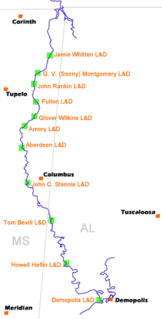
The Tennessee–Tombigbee Waterway is a 234-mile (377 km) man-made waterway that extends from the Tennessee River to the junction of the Black Warrior-Tombigbee River system near Demopolis, Alabama, United States. The Tennessee–Tombigbee Waterway links commercial navigation from the nation's midsection to the Gulf of Mexico. The major features of the waterway are ten locks and dams, a 175-foot-deep (53 m) cut between the Tombigbee River watershed and the Tennessee River watershed, and 234 miles (377 km) of navigation channels. The ten locks are 9 by 110 by 600 feet, the same dimension as the locks on the Mississippi above Lock and Dam 26 at Alton, Illinois. Under construction for twelve years by the U.S. Army Corps of Engineers, the Tennessee–Tombigbee Waterway was completed in December 1984 at a total cost of nearly $2 billion.

13 Alabama Ghosts and Jeffrey is a book first published in 1969 by folklorist Kathryn Tucker Windham and Margaret Gillis Figh. The book contains thirteen ghost stories from the U.S. state of Alabama. The book was the first in a series of seven Jeffrey books, most featuring ghost stories from a Southern state. Jeffrey in the book's title refers to a ghost that allegedly haunts Windham's home.
The Kathryn Tucker Windham Museum is a biographical museum located on the campus of Coastal Alabama Community College in Thomasville, Alabama. It is dedicated to preserving the works of native author, storyteller, and journalist Kathryn Tucker Windham. Windham spent much of her life recording Alabama's history and folklore. The museum was dedicated on June 1, 2003, Windham's 85th birthday.
The explosion of the paddle steamer Saluda, near Lexington, Missouri, in 1852, was one of the worst disasters in Missouri River history.
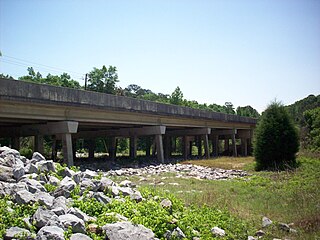
William "Bill" Sketoe, Sr. was a Methodist minister from the south Alabama town of Newton, whose lynching there on December 3, 1864 gave birth to one of Alabama's best-known ghost stories. While locally-told stories of his life usually say that he was hanged on trumped-up charges of desertion from the Confederate Army, other sources show that he was killed for allegedly aiding pro-Union renegades in the area. Whatever the reason for his murder, a shallow hole dug beneath Sketoe's feet during the hanging ultimately led to stories about "the hole that won't stay filled." According to witnesses, this hole never disappeared—even after being filled numerous times—retaining its original dimensions for the next 125 years.

The Lucy Walker steamboat disaster was an 1844 steamboat accident caused by the explosion of the boilers of the steamboat Lucy Walker near New Albany, Indiana, on the Ohio River. The explosion occurred on the afternoon of Wednesday, October 23, 1844, when the steamer's three boilers exploded, caught fire, and sank. It was one of a number of similar accidents of early-19th-century riverine transportation that led to important federal legislation and safety regulations. The vessel's owner was a Native American, her crew were African-American slaves, and her passengers represented a cross-section of frontier travelers.

The Moselle was a riverboat constructed at the Fulton shipyard, in Cincinnati, Ohio. between December 1, 1837 and March 31, 1838. The Moselle was considered one of the fastest river boats in operation at the time, having completed a record-setting two-day, sixteen-hour trip between Cincinnati and St. Louis. On April 25, 1838, the Moselle, piloted by Captain Isaac Perin, suffered a boiler explosion just east of Cincinnati, killing 160 of the estimated 280–300 passengers. The boat had just pulled away from a dock near the neighborhood of Fulton, when all four boilers simultaneously suffered a catastrophic failure resulting in the total destruction of the ship from the paddlewheels to the bow. The ship drifted approximately 100 yards before sinking to the bottom of the Ohio river. Negligence may have been a factor in the explosion: many eyewitness reports claimed that Captain Perin had been racing another riverboat, the Ben Franklin (1836) at the time of the explosion, and therefore the pressure in the boilers was excessively high.
The Eliza Battle was a Tombigbee River steamboat that ran a route between Columbus, Mississippi and Mobile, Alabama during the 1850s. She was destroyed in a fire on the river near modern Pennington, Alabama on March 1, 1858. It was the greatest maritime disaster in Tombigbee River history, with an estimated thirty-three people killed, out of roughly sixty passengers and a crew of forty-five. The disaster and its aftermath saw the Eliza Battle enter southwestern Alabama folklore as a ghost ship, with numerous purported sightings of the burning ship from just north of Pennington to Nanafalia downriver. The story of the disaster and associated folklore has been fictionalized in several published short stories, most notably in “The Phantom Steamboat of the Tombigbee” in 13 Alabama Ghosts and Jeffrey.

The Tombigbee District, also known as the Tombigbee settlements, was one of two areas, the other being the Natchez District, that were the first in what was West Florida to be colonized by British subjects from the Thirteen Colonies and elsewhere. This later became the Mississippi Territory as part of the United States. The district was also the first area to be opened to white settlement in what would become the state of Alabama, outside of the French colonial outpost of Mobile on the Gulf Coast. The Tombigbee and Natchez districts were the only areas populated by whites in the Mississippi Territory when it was formed by the United States in 1798.
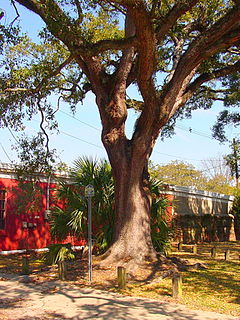
The Boyington Oak is a historic Southern live oak in Mobile, Alabama. In a city with many live oaks that are famous for their age and size, the Boyington Oak stands out as a singular example of one famous for the folklore surrounding its origin.
Horse Creek is a stream and tributary of the Tombigbee River in southern Marengo County and northern Clarke County in Alabama.
Bashi Creek, also historically known as Bashai Creek, is a tributary of the Tombigbee River in northern Clarke County in Alabama.






